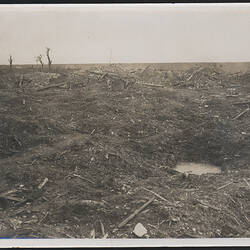Summary
Black and white photographic print.
Attached to a small notebook used as a photograph album, containing 55 black and white photographs of ANZAC soldiers in Egypt, Mudros and Gallipoli during World War I. The photographs were taken by an Australian soldier, Sergeant John Lord or one of his friends (to be verified). John Lord served in the 13th Field Ambulance and returned to Australia shortly after the end of the War in 1919.
The album was one of many souvenirs brought back to Australia after World War I by Lord. Part of a larger collection of photograph albums, images, documents and World War I memorabilia donated by John Lord to Museum Victoria.
Image depiciting the Pontoon Bridge across the Canal (possibly the Suez Canal, Egypt) and the Canal defence. The image is dated to 1916.
Description of Content
Canal with pontoon. A small ship with crane attachment sits in the middle of the canal, next to a small row boat. On the bank in the foregound are approximately twelve men, either standing or on horseback. Wooden barrels and carts fill the foreground, while on the far bank, more horses, trees and a tent can be seen.
Physical Description
Black and white photograph, mounted in a small, blue, army-issued notebook used as a photograph album.
Significance
This photograph is in a very significant album which includes a number of excellent photographs of Australian soldiers at Gallipoli and surrounding areas. Some of these are particularly clear and well-composed - for example, 'Rest Gully Anzac' shows hundreds of soldiers sitting and standing around talking and a valley with lots of dugouts and shelters. 'Old Kit etc at Anzac Ordnance Stores 1915' is another clear photograph, ,showing rubbish that the Anzacs generated at Gallipoli. Many of the photographs were taken when the weather was hot, but there are also a number of images taken in the snow. Another, 'Extreme Right of Anzac' demonstrates the steepness of the terrain and the mixture of clothing that the soldiers wore. All of the photographs appear to have been taken at times when the photographer was 'off duty', since the images are of the landscape or soldiers at rest.
More Information
-
Collection Names
Military Memorabilia Collection, John Lord Collection, Returned and Services League (RSL) Collection
-
Collecting Areas
-
Acquisition Information
Donation from J. Lord, 24 Feb 1986
-
Place & Date Depicted
-
Previous Owner
Sergeant John Lord
Private John Lord was originally identified as the photographer of the album, but as there is no record of him serving on Gallipoli, and images in the album depict Gallipoli, the photographer is probably an unknown soldier. -
Format
Photograph, Black & White
-
Inscriptions
Hand written in pencil below the image: 'Pontoon Bridge across the / Canal. ... Canal Defense 1916'
-
Classification
-
Category
-
Discipline
-
Type of item
-
Image Dimensions - Photograph
65 mm (Width), 45 mm (Height)
-
Image Dimensions - Photograph album page
145 mm (Width), 100 mm (Height)
-
Keywords
Australian Army, Militaria: Australian, Military Memorabilia, Wars & Conflicts, World War I, 1914-1918


